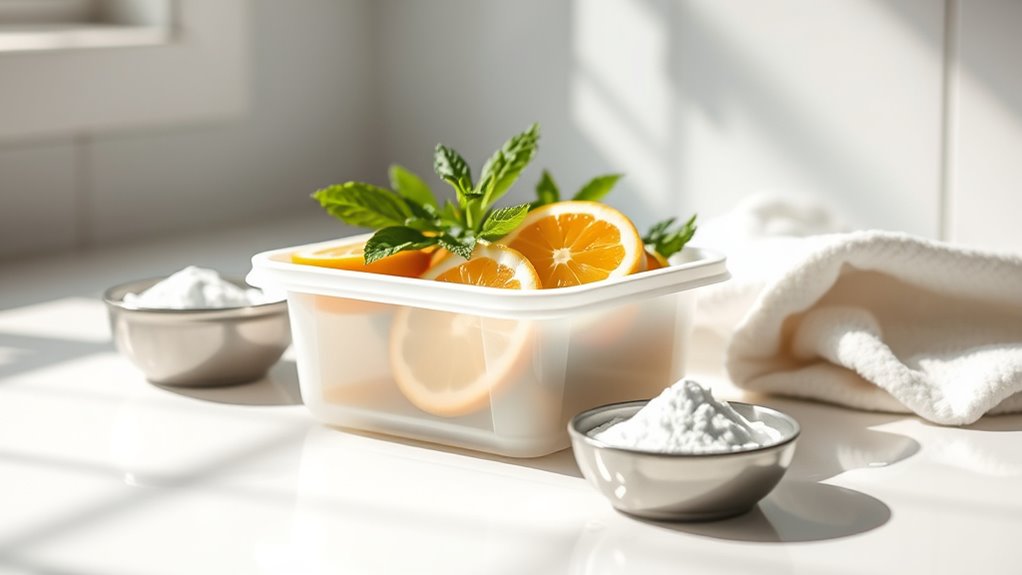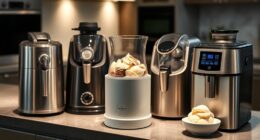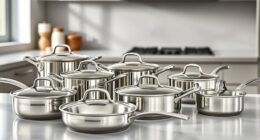To eliminate odors and stains from plastic containers, soak them in a vinegar solution or a baking soda paste. Rinsing with lemon juice can tackle tough stains too. Exposing containers to sunlight helps break down odorous molecules naturally. Always wash containers with hot, soapy water immediately after use and make certain they’re completely dry before storing. With these tips, you can keep your plasticware fresh and clean, and there’s more to discover about maintaining their longevity.
Key Takeaways
- Soak plastic containers in a vinegar solution for 30 minutes to neutralize odors and remove stains effectively.
- Use a baking soda paste on stubborn stains and let it sit before rinsing to absorb lingering odors.
- Rinse containers with fresh lemon juice and expose them to sunlight for natural bleaching and odor reduction.
- Wash containers immediately with hot, soapy water to prevent food particles from causing odors and stains.
- Store strong-smelling foods in airtight bags to prevent odor transfer to other containers.
Understanding Common Odors in Plastic Containers
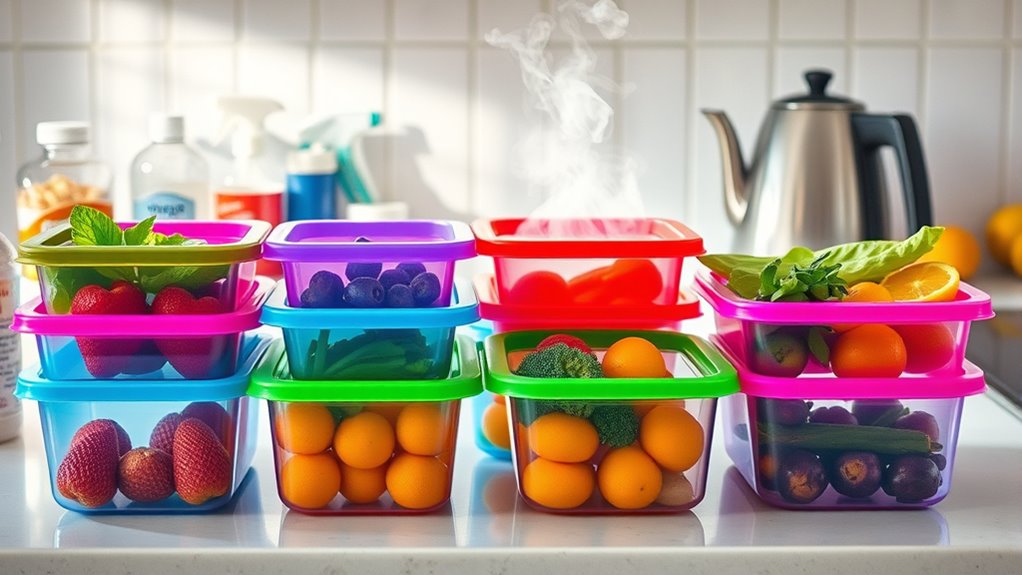
Have you ever wondered why your plastic containers seem to hold onto unpleasant smells? It often comes down to residual food particles hiding in corners, which can create lasting odors. Moisture accumulation is another culprit; if you store your containers without fully drying them, mold and mildew can thrive. Plus, the porous nature of plastic allows it to absorb smells from whatever food you’ve stored. Strong-smelling items like fish or tomato sauce can leave particularly stubborn odors. When you microwave these containers, the heat can embed stains and smells even deeper, making them harder to eliminate. Regular maintenance is essential to prevent odor development; all these factors contribute to the unpleasant experience of using your containers, affecting both their durability and your food’s taste.
Effective Methods to Eliminate Odors
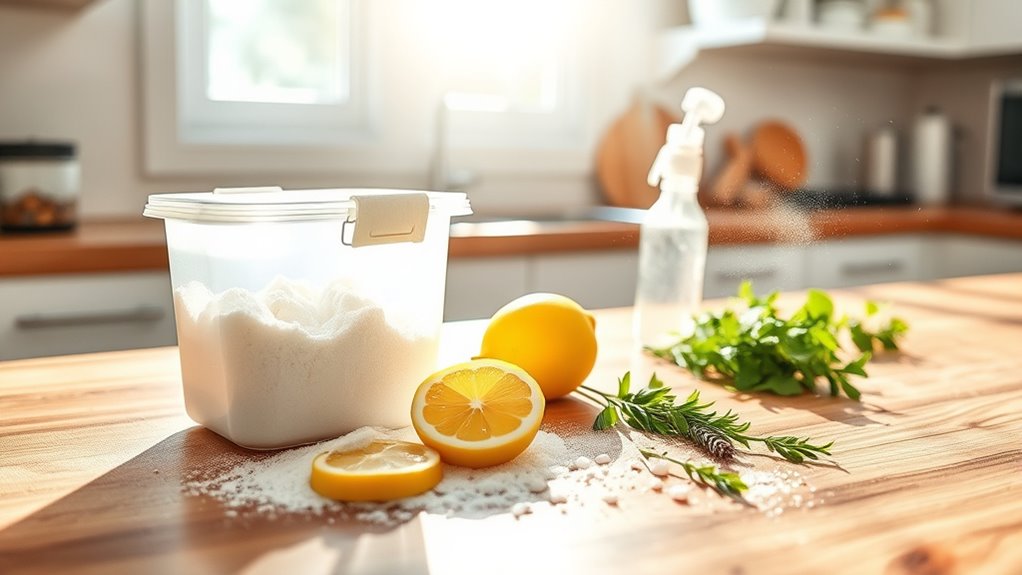
Eliminating odors from plastic containers can be straightforward with the right methods. Start by soaking your containers in a vinegar solution to neutralize unwanted smells. Alternatively, a baking soda soak or paste effectively absorbs and eliminates odors. For an extra boost, rinse your containers with lemon juice, which also tackles stains. Sunlight exposure can work wonders; leaving the containers outside helps break down odor-causing molecules. Don’t forget to wash your containers in hot water to remove any lingering food particles. Regular cleaning with soap and water prevents odor build-up, and make sure your containers are completely dry afterward to avoid moisture. Using microfiber cloths can enhance your cleaning process, making it easier to maintain freshness. Additionally, using dishwashing liquid along with hot water can help in the initial cleaning of your containers before applying further deodorizing treatments.
Natural Odor-Removing Agents

When it comes to tackling stubborn odors in plastic containers, natural odor-removing agents can be incredibly effective. Baking soda is a go-to because it absorbs and neutralizes acidic smells. Activated charcoal enhances odor absorption thanks to its porous structure. If you prefer a fresh scent, plant-based oils can mask unpleasant odors while adding a pleasant aroma. Treated salt not only absorbs odors but also has antimicrobial properties to help eliminate odor-causing germs. Enzymes work wonders by breaking down the molecules responsible for bad smells, making them suitable for industrial odor control. Additionally, using natural remedies such as honey can provide an extra layer of protection against odors, thanks to its inherent antimicrobial properties. These agents are non-toxic, eco-friendly, and often more cost-effective than chemical alternatives, making them ideal choices for keeping your containers odor-free and safe.
Techniques for Stain Removal
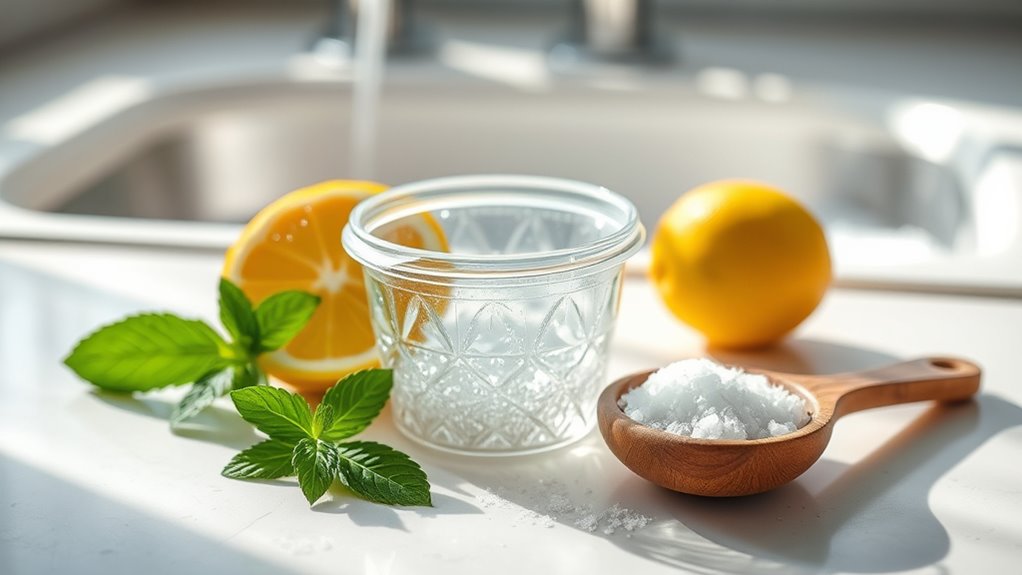
While stubborn stains on plastic containers can be frustrating, several effective techniques can help you tackle them.
Start with common household cleaners like a mixture of equal parts water and white vinegar, soaking the container for 30 minutes to a few hours. Vinegar solution is non-toxic and eco-friendly, making it safe for cleaning food containers and children’s toys.
Baking soda paste can also work wonders—just apply it and let it sit. For natural bleaching, use fresh lemon juice in sunlight.
If you’re dealing with tough stains, a diluted bleach solution or denture tablets submerged overnight can be effective.
For specific stains, like tomato sauce or grease, a combination of baking soda and dish soap may do the trick.
Finally, use soft-bristle brushes and non-abrasive pads to scrub without damaging the plastic.
Preventing Future Odors and Stains
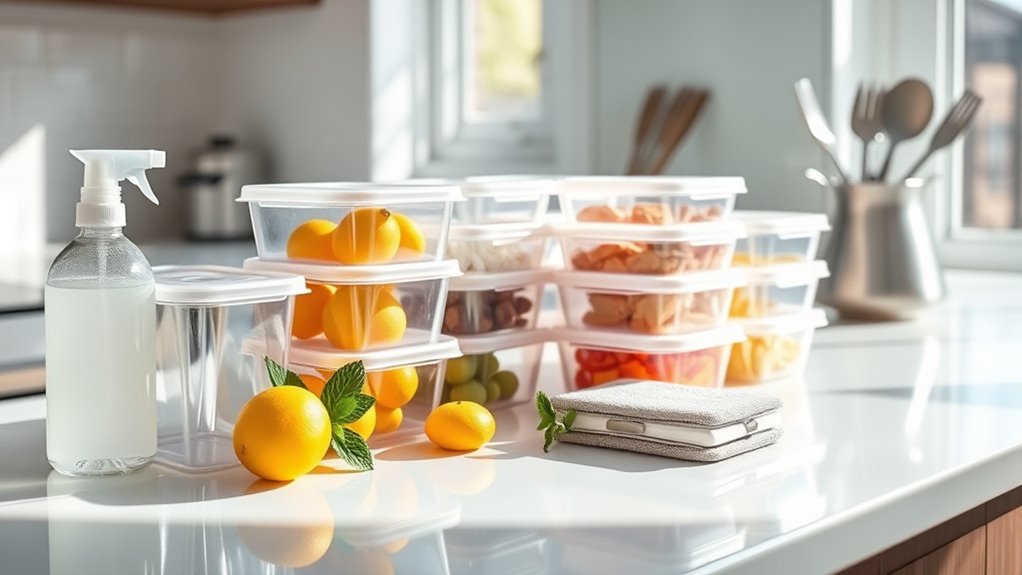
To keep your plastic containers odor-free and stain-free, it’s essential to adopt proactive cleaning and storage habits.
First, wash your containers with soap and hot water immediately after use to prevent food residue buildup. Make sure to dry them completely before storing to avoid moisture that can lead to mold. Additionally, regularly check for tiny holes or crevices in plastic that can trap food particles.
Avoid microwaving in plastic, as it can create micro holes for odors and bacteria. Store strong-smelling foods in airtight bags, and keep them separate from other items.
Periodically air your containers for fresh circulation and avoid overcrowding to reduce moisture.
Finally, choose durable plastics and consider glass for acidic foods, ensuring a cleaner and fresher storage environment for your containers.
Essential Tools and Materials for Cleaning
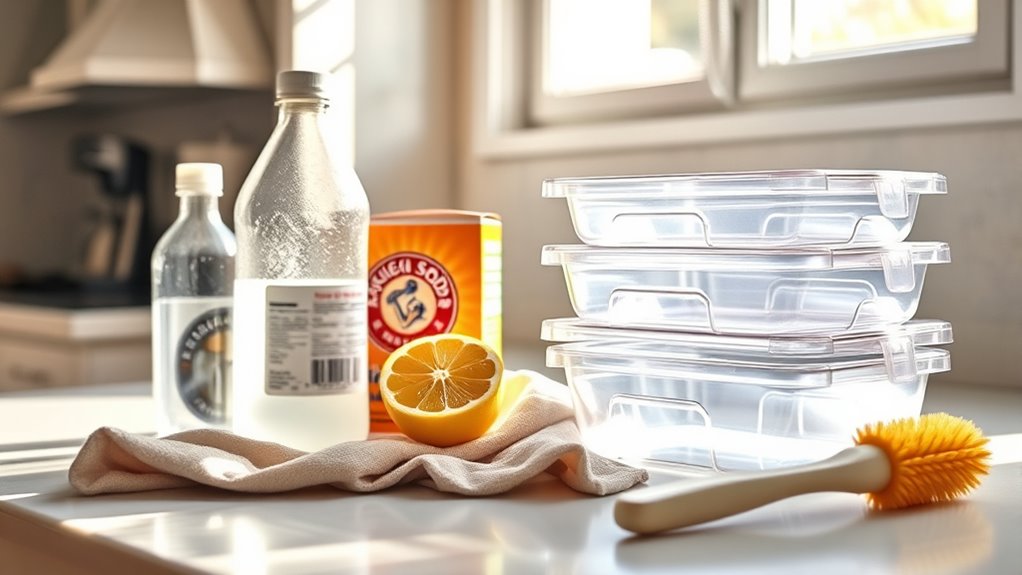
Cleaning plastic containers effectively requires a few essential tools and materials that make the process easier and more efficient. Start with soft brushes or sponges to scrub without scratching. A microfiber cloth is perfect for wiping down surfaces and removing residue. Use mild dishwashing liquid for cleaning, and consider a high-pressure sprayer hose for those hard-to-reach areas. You’ll also need cleaning materials like baking soda, vinegar, and lemon juice for odor absorption and stain removal. Always choose detergents safe for food contact. Additionally, ensure that you are following current good manufacturing practices to maintain cleanliness and safety in your cleaning process. Don’t forget personal protective equipment, like gloves and goggles, to guarantee your safety while handling cleaning agents. With these tools and materials, you’ll be well-equipped to tackle odors and stains in your plastic containers.
Step-by-Step Odor Removal Process
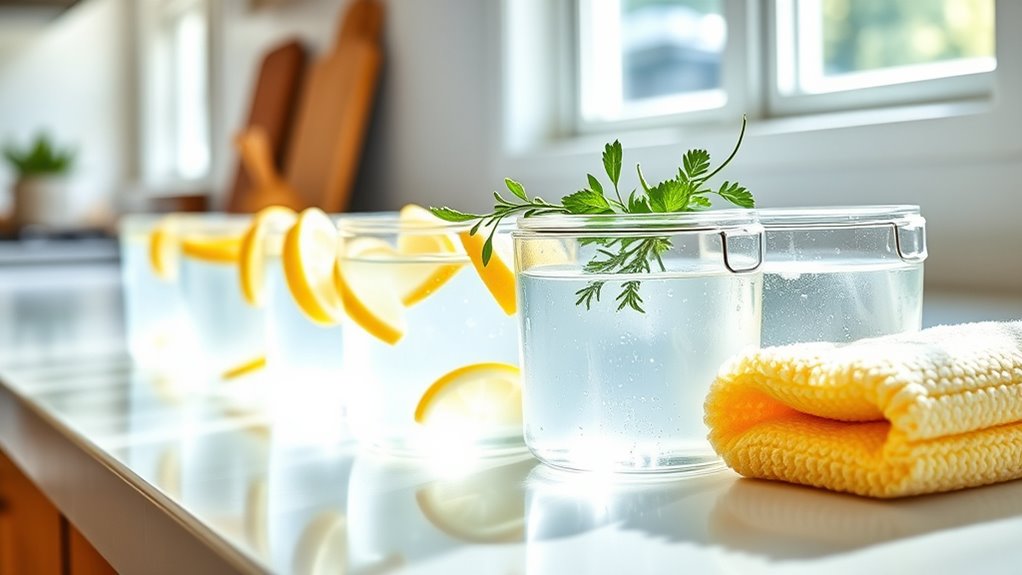
If you’ve noticed persistent odors in your plastic containers, don’t worry—removing them is straightforward. Start by washing the container with hot water and dish soap to eliminate any visible food particles. Next, fill the container with equal parts vinegar and water, letting it sit for a few hours. For stubborn odors, create a baking soda soak in warm water and leave it overnight. You can also try placing the container in the freezer for 15-20 minutes to neutralize smells. Finally, expose the container to sunlight with the lid open to break down odor-causing molecules. Remember that plastic containers are made from porous plastic material, which can absorb odors. Repeat these steps as needed until the odors are gone, and your containers will be fresh and ready for use.
Best Practices for Storing Food in Plastic Containers

When storing food in plastic containers, it’s essential to prioritize safety and freshness. Choose food-grade, BPA-free materials like polyethylene or polypropylene to prevent chemical leaching. Confirm lids fit tightly to keep out moisture and air. Additionally, using proper containers can extend shelf life of stored food. Using proper storage techniques can also help prevent financial scams that target those who may be unaware of food safety practices.
Prioritize safety and freshness by using BPA-free plastic containers with tight-fitting lids for food storage.
Incorporating advanced filtration systems in your home can further enhance indoor air quality, making your food storage environment safer. Store containers in dry conditions, away from heat and sunlight, to avoid warping. Maintain a consistent temperature around them to prevent damage. Always wash containers with warm soapy water before first use and inspect them for any damage.
It’s a good idea to label containers with contents and dates for easy identification. Minimize air exposure by using airtight containers, and if you’re freezing food, make certain to use freezer-safe options. Following these practices keeps your food safe and fresh longer.
Tips for Maintaining Freshness and Cleanliness
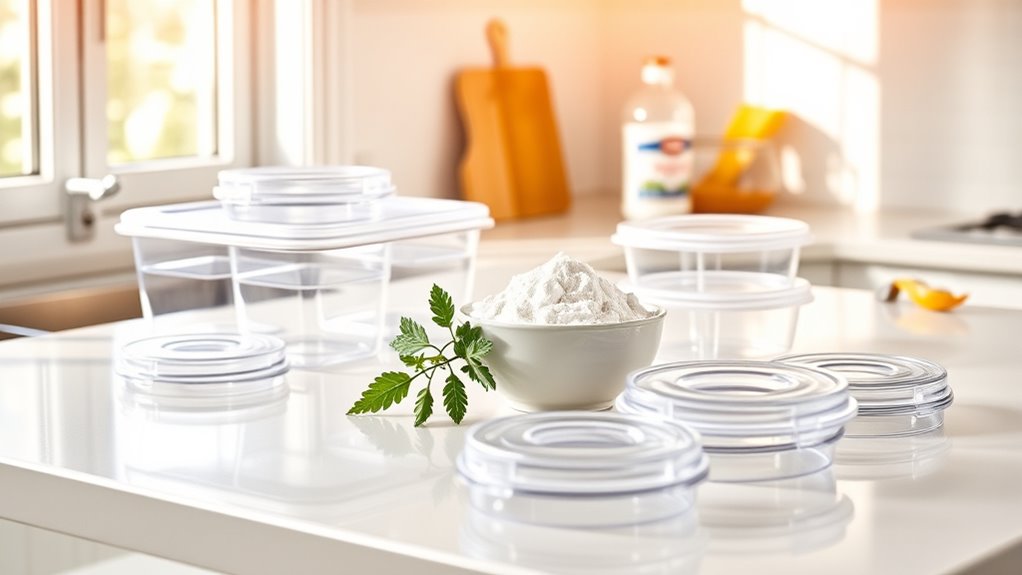
Maintaining freshness and cleanliness in plastic containers is key to prolonging their life and ensuring the safety of your food. Start by washing your containers regularly with mild soap and water, and always dry them thoroughly to prevent moisture buildup. Use soft sponges to avoid scratching the surfaces. To tackle stubborn odors, soak the containers in a baking soda solution or rinse them with vinegar. Air them out occasionally to reduce staleness. When storing, keep strong-smelling foods separately in airtight bags, and use odorless linings to minimize smell transfer. Regularly inspect your containers for stains and odors, and avoid storing them in hot or humid areas to maintain their integrity and freshness. Additionally, ensuring adequate ventilation can help prevent moisture buildup, which is crucial for maintaining a dry environment inside your containers.
Frequently Asked Questions
Can I Use Bleach to Remove Odors From Plastic Containers?
Yes, you can use bleach to remove odors from plastic containers. Just mix equal parts bleach and water, apply it to the container, and let it sit for about four hours.
After that, rinse thoroughly to guarantee no bleach residue remains. Make sure the container can handle bleach without damage.
If you prefer, a less concentrated solution can work, too, but soak for only about an hour. Always clean with soap and water afterward.
How Often Should I Clean My Plastic Containers?
You should clean your plastic containers regularly, especially after storing food.
If you notice stains or spills, clean them immediately. In humid or warm conditions, increase your cleaning frequency to prevent moisture buildup.
If you detect unpleasant odors, it’s time to act. Establish a routine based on how often you use them.
Are There Specific Foods That Cause More Odors in Plastic?
Yes, certain foods definitely cause more odors in plastic.
Strong-smelling items like garlic, onions, and fish can leave lingering scents.
Acidity from citrus fruits and tomatoes might make the plastic absorb odors, while fermented foods like kimchi can release gases that stick around.
Oily and fatty foods, along with high-salt items like cured meats, can also contribute to unpleasant smells.
It’s best to be mindful of what you store in plastic containers.
Will Dishwasher Cleaning Eliminate All Odors From Plastic Containers?
No, dishwasher cleaning won’t eliminate all odors from plastic containers.
While it effectively removes surface residues, deeper odors might linger.
After dishwashing, you might want to use vinegar or baking soda to tackle stubborn smells.
Make sure your containers are completely dry; moisture can lead to odors.
Regular cleaning and proper storage techniques can help prevent future issues, so keep an eye on how you maintain your containers for the best results.
Can I Microwave Plastic Containers to Remove Odors?
You shouldn’t microwave plastic containers to remove odors.
Doing so can weaken the plastic, causing it to release harmful chemicals and potentially create holes that trap bacteria. Plus, microwaving doesn’t effectively eliminate deep-set odors; it might even make them worse.
Instead, try soaking the container in a solution of baking soda, vinegar, or lemon juice. These natural methods are safer and more effective for tackling stubborn smells without damaging your containers.
Conclusion
In the battle against stubborn odors and stains in your plastic containers, don’t let frustration win! With simple methods and natural agents at your fingertips, you can reclaim freshness and keep your kitchen inviting. Imagine opening your cupboard to find containers that smell as good as they look—it’s not just a dream. By following these tips and maintaining cleanliness, you’ll guarantee your food stays fresh, and your space remains a haven of comfort.
